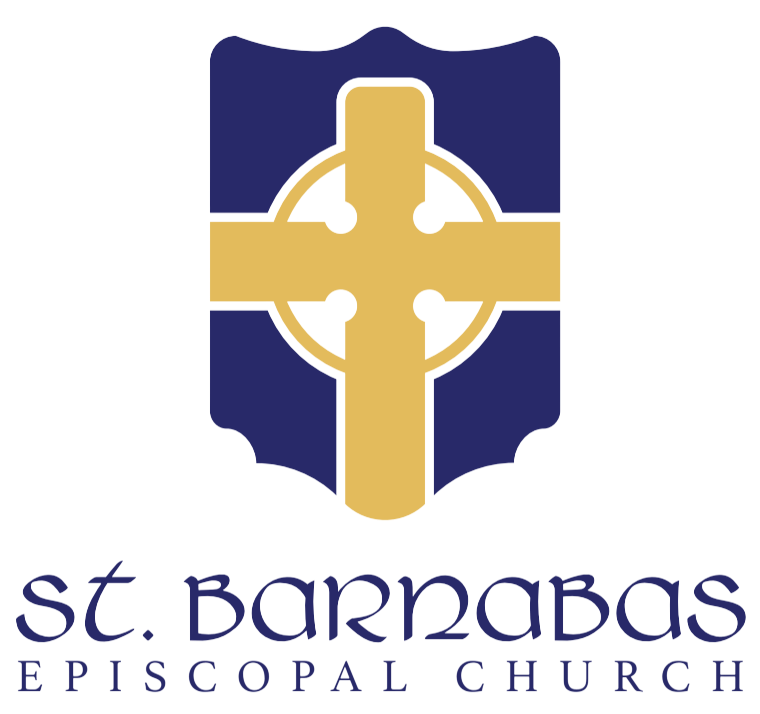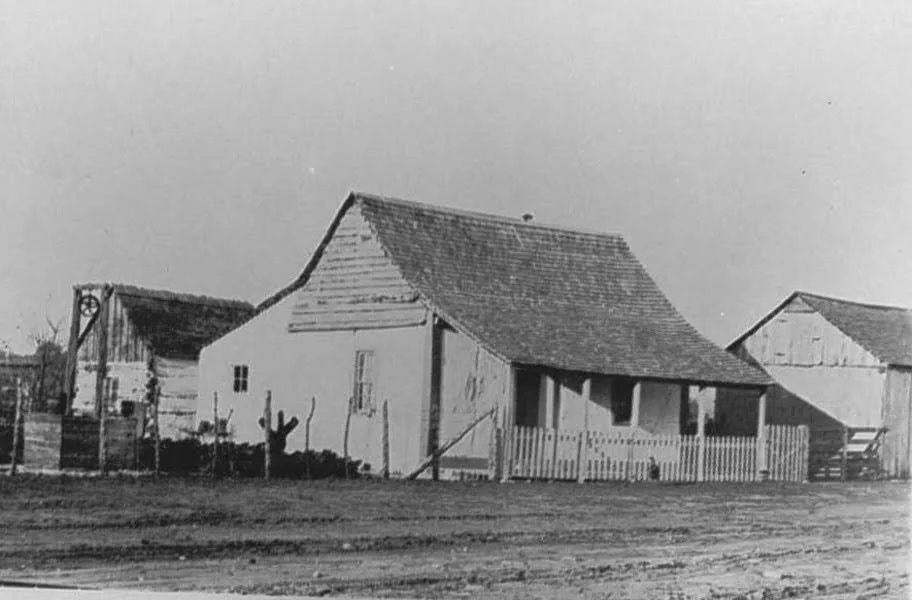Our History
Saint Barnabas Church’s rich history dates back to 1847 when the original owners moved to Fredericksburg from a small German village and started their family home. It passed through various ownership until it was purchased and named the new Episcopal mission of Saint Barnabas.
The building and campus have undergone a number of renovations and additions over the years, creating the beautiful space we enjoy today. The Saint Barnabas congregation values community, encouragement, and welcoming all to worship with us. Our welcoming community has even gotten national and international attention as President Lyndon B. Johnson and his wife Lady Bird worshiped with us. When Lady Bird Johnson was asked why she enjoyed being a member at Saint Barnabas, she said, “Because you treat me just like everyone else.”
Learn more about the history of Saint Barnabas Church below.
The Walter Home
The arrival of Peter and Anna Margarethe Walter in Fredericksburg in early 1847 marked the end of an exhausting five-month journey. The Walters and their four children traveled first from their German village in Hessen to the coast of the North Sea. At Antwerp, they departed on a ten-week sea voyage. On November 30, they landed at Galveston and then traveled overland by oxcart and foot to New Braunfels. Only one month later, Mrs. Walter gave birth to their fifth child, Catherine. Soon after, they moved on to Fredericksburg to begin their new lives in Texas.
The German Emigration Company granted them Town Lot No. 464, located at the west end of town near the creek. Urgently needing shelter, the Walters quickly built a rough log house. Life was hard and their days were filled with unrelenting labor. The Walters at least had the comfort of their kinsmen close by; Peter’s sister and her husband, Marie and Heinrich Dietz, built across the street.
The Walters soon began building their permanent home, a two-room fachwerk structure, of rough-hewn logs, rocks, and mortar. This building technique was common in the German villages of their birth. Later they added the back room of hand-cut limestone. The Walters purchased several adjoining lots for farming and built a wooden barn close to the house. The original log cabin served as their kitchen.
Farming was the Walter’s main livelihood, but Peter also carried freight by ox-drawn wagon between Fredericksburg, San Antonio, Loyal Valley, and Fort McKavett. In 1865, Peter Walter died tragically when a run-away team threw him from his wagon.
In 1877, William, the third son, and his wife Sophie, bought the property from his mother and siblings. Like his father, William supplemented their farm income by carrying freight. His mother lived with them until her death in 1886. William died in 1920 and his wife Sophie in 1931, leaving the property to their only child, Minna Walter Lang.
A New Church Home
In 1946, a group of eight Fredericksburg Episcopalians began meeting once a month in one another’s homes. In 1952, Rev. Wilson Rowland, a young priest who served the Episcopal Mission of St. Boniface in nearby Comfort, volunteered to establish an Episcopal mission in Fredericksburg. The group, now made up of five families with 16 members, met at the Nimitz Hotel or in private homes.
In 1954, Rev. Rowland noticed that the Walter property on Creek Street was for sale. The buildings were in poor repair, but he saw the property’s potential as a home for the congregation. Milton Edwards, H. H. Fricke, and Rev. Rowland purchased the property from Minna Walter Lang on June 13. They signed a promissory note for $2,500 at 4% interest, to be paid in 120 monthly installments of $25.32.
For three months, the congregation worked hard to create a place of worship out of the 106-year-old structure. They replaced the rotted pine floors with bricks and covered the exterior sides with overlapping wood shingles. They held their first worship services in the building in September 1954.
On December 23, 1954, Rt. Rev. Everett H. Jones dedicated the building and named the new mission St. Barnabas. For the next ten years, the pioneer home of the Walter family would be the worship center of the Episcopal Mission of Saint Barnabas. After the new sanctuary was built in 1964, the building continued to be used as a chapel, office, and fellowship hall.
In 1983, the church conducted a major restoration of the chapel. The restoration team installed antique wood floors, stabilized the beams and walls, and removed the exterior side shingles. With the timbers, rocks and mortar exposed, the building appeared much as it had for its first 100 years.
A Place of Inspiration
On January 31, 1965, the new St. Barnabas Episcopal Church was consecrated by the Rt. Rev. Everett H. Jones, along with the Priest-in-Charge, the Rev. Jack Langford. The congregation, with 50 communicants, had outgrown the little chapel. Though the historic building is no longer the primary site for worship, it is a cherished part of parish life.
Through the years, the chapel has remained a holy place of prayer and inspiration – a place of celebration and solace. It has been a witness to events both joyful and sad: weddings, baptisms and funerals. Those whose loved one’s remains lie in the adjacent Columbarium often visit the chapel for prayer and contemplation. Once a week, a special noon service in the chapel offers healing and comfort for those who are sick and suffering. The building is open every day around the clock for individual prayer.
The former Walter family home, now the gateway to the St. Barnabas campus, is one of the oldest buildings in Fredericksburg. The farm fields, barn, and log cabin are gone; but the house, more than 160 years old, remains, along with the well and grape arbor, where Peter and Anna Margarethe Walter placed them.
St. Barnabas Episcopal Church has celebrated many milestones since the first eight Episcopalians in Fredericksburg began worshipping together in 1946. Their first church home stands today as a tribute to the vision and faith of those founding members.
The Early Years
When the first German settlers arrived in Fredericksburg in May of 1846, they had left friends and family, their homes and most of their possessions behind. They faced tragic losses and near starvation before they could establish secure homes in the new land. Hope for a more free and prosperous future and a strong faith in God strengthened them to endure the miseries of the trip and the suffering to come.
Though the early years were difficult, the German Immigration Company, or Adelsverein, continued to promote emigration from Germany to Texas and by 1850, Fredericksburg was home to more than 1000 people. The Adelsverein was a group of German investors formed in 1842 to establish settlements in Texas. Among other enticements to potential emigrants, they promised to build a church and hire a minister for the each new community.
The first settlers in Fredericksburg were primarily Lutheran, but there were also a number of Catholics and Methodists. Regardless of individual belief, each immigrant was required by the Adelsverein to have a baptismal certificate.
For the first year, the settlers held worship services outdoors under a tree close to the center of town. In 1848, the Adelsverein helped the settlers to build the Vereins Kirche or Society Church, Fredericksburg’s first public building. At first all worshipped there together, but soon some denominations began to leave and build their own churches. St. Mary’s Catholic Church, Zion Lutheran Church and the First Methodist Church were the earliest to break away. Many Lutherans continued to worship in the Vereins Kirche until the 1880s when both Bethany and Holy Ghost Lutheran separated and built new churches.
Over the years, newcomers to Fredericksburg brought other faiths with them. By the mid- 20th century, the Baptists, Presbyterians, Church of Christ, and Episcopalians had established churches here.
The Johnsons
Just like everyone else
During the 1960s, the Episcopal Mission on Creek Street attracted national and international attention. The first family, President Lyndon B. Johnson and his wife Lady Bird, and their two daughters, Lynda and Luci, attended services here when they were at the Texas White House in nearby Stonewall. They often brought illustrious guests as well. The Secret Service men and press overwhelmed the small building, pushing regular attendees into the back room or out on the front porch.
At the laying of the cornerstone for the new sanctuary on November 11, 1964, Mrs. Johnson presented an additional stone from the St. Barnabas Monastery in Cyprus. Taken from the site where St. Barnabas is said to have died a martyr’s death, this limestone rock had been given to her by Archbishop Makarios when she and the President visited Cyprus in 1962. The Johnsons each placed trowels of mortar as the stone was placed on the south wall of the new sanctuary. On December 23, 1964, they attended the first service held in the new worship center.
After the President’s death in 1973, Lady Bird continued to worship at St. Barnabas, transferring her letter of membership from St. David’s in Austin. When asked why she had done this, Lady Bird replied, “Because you treat me just like everyone else.” Parishioners remember her racing into Sunday worship, almost late, and bringing her famous fried chicken and home-made biscuits to the church’s first-Sunday potlucks.
Lady Bird loved St. Barnabas and she especially loved the little chapel. Shortly before her death, Lady Bird made a generous gift to St. Barnabas, in honor of the Rev. Dean Pratt, Rev. Stephen Kinney, and Rev. Dick Elwood, saying, “I feel the time has come for me to repay a part of the debt for the irreplaceable gifts of comfort, strength, and abiding faith I have received.”







